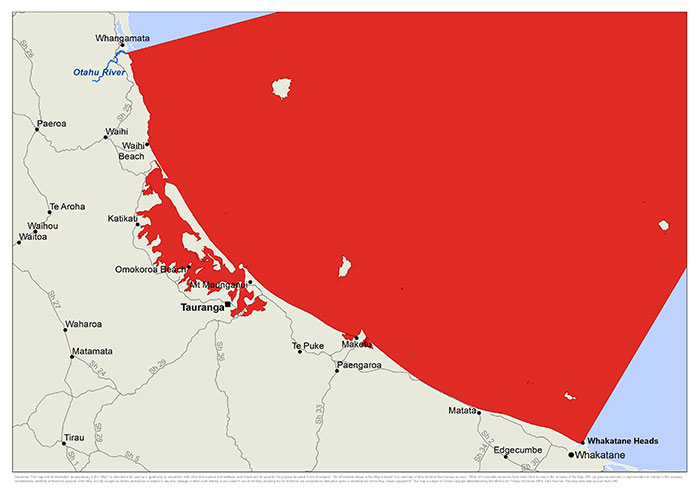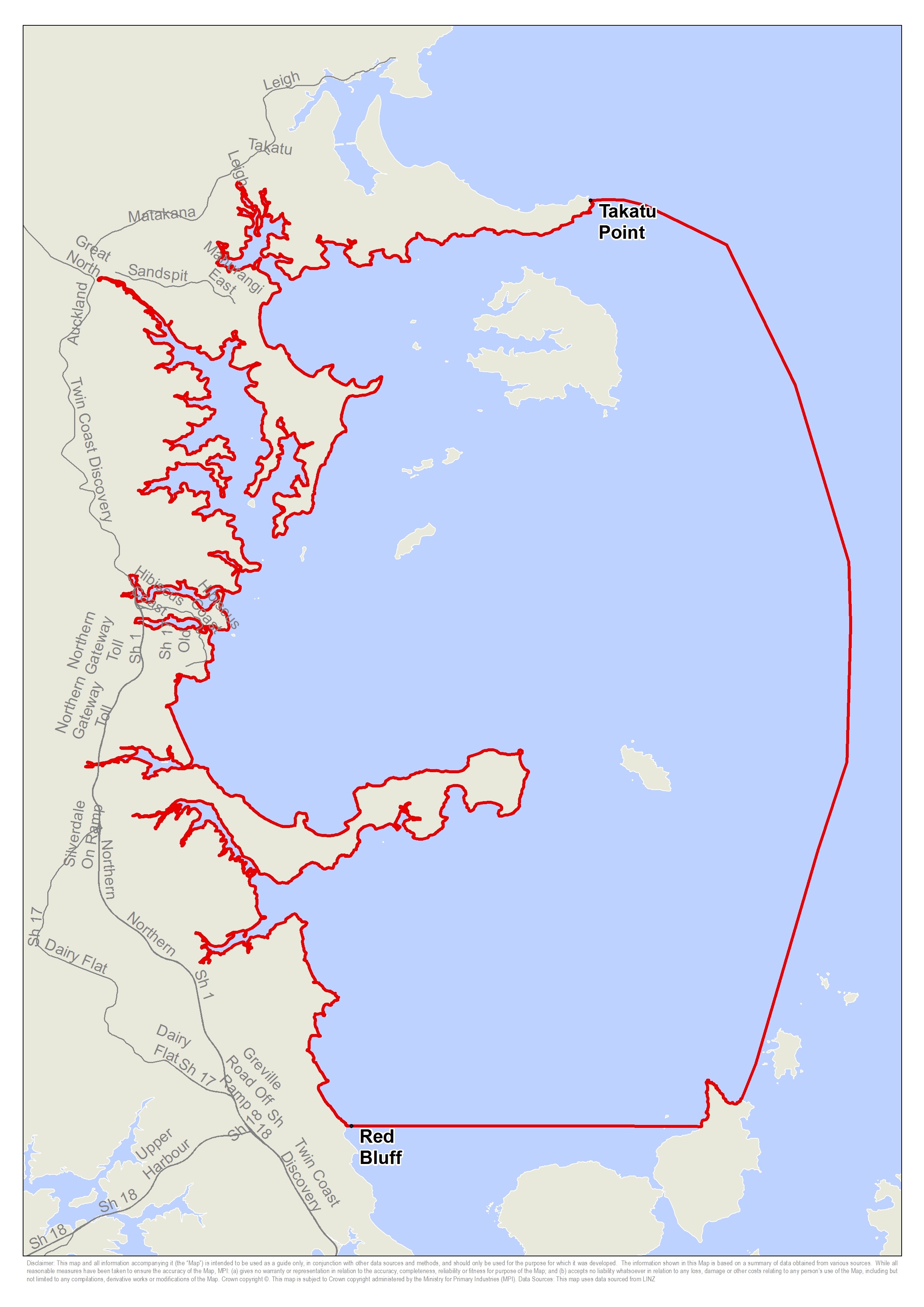Public warnings about toxic shellfish
Shellfish and seawater samples are taken every week from popular shellfish gathering areas around New Zealand and are tested for the presence of toxic algae. If the shellfish are not safe to eat, then public health warnings are issued and signs are posted at affected beaches.
The information on this page relates only to the non-commercial (recreational and traditional) taking of shellfish. Commercially harvested shellfish – sold in shops and supermarkets, or exported – is subject to strict water and flesh monitoring programmes by MPI to ensure they are safe to eat.
Subscribe to email updates about shellfish biotoxin warnings
North Island warnings
There is one warningare two warnings in place for the North Island:
Whangaparaoa region – Takatu Point south to Red Bluff at Campbells Bay- Bay of Plenty
Bay of Plenty
| Reason for alert | Paralytic Shellfish Poisoning (PSP) |
| Date warning issued | 19 February 2016 reissued 21 July 2016 |
| Affected area | From the mouth of the Otahu River at the southern end of Whangamata Beach, southwards all the way down to the Whakatane Heads. The area includes Tauranga Harbour, Maketu and Waihi estuaries, Matakana and Motiti Islands, and all other islands along this coastline. |
| Shellfish affected | Mussels, oysters, tuatua, pipi, toheroa, cockles, scallops, catseyes, kina (sea urchin) and all other bivalve shellfish. Note, cooking shellfish does not remove the toxin. Pāua, crab and crayfish may still be eaten if the gut has been completely removed prior to cooking, as toxins accumulate in the gut. If the gut is not removed its contents could contaminate the meat during the cooking process. |
| Other information | PSP toxins have been detected in shellfish at levels over the safe limit of 0.8mg/kg set by MPI. Ongoing testing will continue and any changes will be communicated accordingly. |
Map: The affected area in the Bay of Plenty
 Map showing the area covered by the shellfish biotoxin alert from the mouth of the Otahu River to the Whakatane Heads.
Map showing the area covered by the shellfish biotoxin alert from the mouth of the Otahu River to the Whakatane Heads. South Island warnings
No warnings are in place for the South Island.
If you get sick after eating shellfish
If anyone becomes ill after eating shellfish from an area where a public health warning has been issued:
- phone Healthline for advice on 0800 61 11 16, or seek medical attention immediately
- advise your nearest public health unit
- keep any leftover shellfish in case it can be tested.
Find your nearest public health unit
Find out more
- Food Safety for Seafood Gatherers booklet
- Causes and symptoms of toxic shellfish poisoning
- Toxic algal blooms
- Collecting Shellfish and Keeping Them Safe
Whangaparaoa region – Takatu Point south to Red Bluff
Following further sampling of water and shellfish, MPI has extended the current biotoxin warning for the Whangaparaoa region. The warning now starts from Red Bluff at Campbells Bay and extends northwards to Takatu Point. This warning includes the Mahurangi Harbour, Kawau Island and other offshore islands in the vicinity. Commercial oyster farms in the Mahurangi Harbour are being monitored and are not being harvested.
| Reason for alert | Paralytic Shellfish Poisoning (PSP) |
| Date warning issued | 23 June 2016 |
| Affected area | The warning has been extended to include Red Bluff at Campbells Bay and extends northwards to Takatu Point, just north of Kawau Island. The extension includes the Mahurangi Harbour, Kawau Island and other smaller offshore islands in the vicinity. Commercial oyster farms in the Mahurangi Harbour are being monitored and are not being harvested. |
| Shellfish affected | Mussels, oysters, tuatua, pipi, toheroa, cockles, scallops, catseyes, kina (sea urchin) and all other bivalve shellfish. Note, cooking shellfish does not remove the toxin. Pāua, crab and crayfish may still be eaten if the gut has been completely removed prior to cooking, as toxins accumulate in the gut. If the gut is not removed its contents could contaminate the meat during the cooking process. |
| Other information | Further testing has resulted in MPI expanding the current warning. PSP toxins have been detected in shellfish over the safe limit of 0.8mg/kg set by MPI. Ongoing testing will continue and any changes will be communicated accordingly. |
Map: The affected area in the Whangaparaoa Peninsula
 Map showing the area covered by the shellfish biotoxin alert from Red Bluff at Campbells Bay and extends northwards to Takatu Point, just north of Kawau Island
Map showing the area covered by the shellfish biotoxin alert from Red Bluff at Campbells Bay and extends northwards to Takatu Point, just north of Kawau Island
Bay of Plenty
| Reason for alert | Paralytic Shellfish Poisoning (PSP) |
| Date warning issued | 19 February 2016 – valid until further notice |
| Affected area | From the mouth of the Otahu River at the southern end of Whangamata Beach, southwards all the way down to the Whakatane Heads. The area includes Tauranga Harbour, Maketu and Waihi estuaries, Matakana and Motiti Islands, and all other islands along this coastline. |
| Shellfish affected | Mussels, oysters, tuatua, pipi, toheroa, cockles, scallops, catseyes, kina (sea urchin) and all other bivalve shellfish. Note, cooking shellfish does not remove the toxin. Pāua, crab and crayfish may still be eaten if the gut has been completely removed prior to cooking, as toxins accumulate in the gut. If the gut is not removed its contents could contaminate the meat during the cooking process. |
| Other information | PSP toxins have been detected in shellfish at levels of up to 2.3mg/kg which is over the safe limit of 0.8mg/kg set by MPI. Ongoing testing will continue and any changes will be communicated accordingly. |
Map: The affected area in the Bay of Plenty
 Map showing the area covered by the shellfish biotoxin alert from the mouth of the Otahu River to the Whakatane Heads.
Map showing the area covered by the shellfish biotoxin alert from the mouth of the Otahu River to the Whakatane Heads. South Island warnings
No warnings are in place for the South Island.
If you get sick after eating shellfish
If anyone becomes ill after eating shellfish from an area where a public health warning has been issued:
phone Healthline for advice on 0800 61 11 16, or seek medical attention immediatelyadvise your nearest public health unitkeep any leftover shellfish in case it can be tested.
Find your nearest public health unit